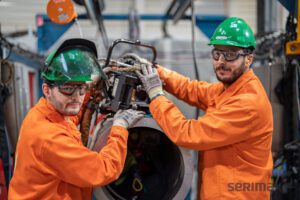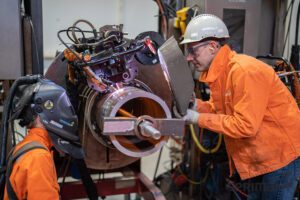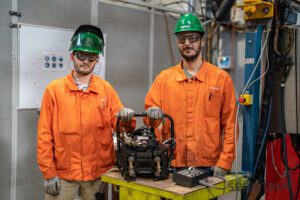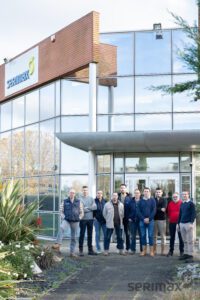Nuclear Welding

Today’s team of experts is Augustin and Quentin; they manage Nuclear Welding projects at Serimax and are also part of Olivier Revel’s team.
Augustin (on the left of the photo), Quentin (on the right): tell us about their work-experience…
Can you both tell us a little bit about your experience?
Quentin: I completed my preparatory class and then secured the prestigious “Art et Métiers” diploma from Chalons en Champagne, France. After two years of training as an industrial engineer, I obtained a dual degree with ESSA (Welding Institute – Yutz) to become a welding engineer. I then did a 6-month internship with Serimax working at the heart of the research and development (R&D) department and was hired following successful completion just after acquiring my International Welding Engineer diploma and engineering degree in 2019.
Augustin: Similar to Quentin really just in a different location, I began with a preparatory class and then integrated the French “Arts et Métiers” in Metz. After two years of training as a general industrial engineer, I obtained a diploma from the ESSA (welding institute – Yutz) to then go on and become a certified international welding engineer (IWE). With all this under my belt I was then offered a position at Serimax where I went on to finish my studies in 2020.


As Serimax is well-known for success in the oil and gas (O&G) industry on various projects worldwide, how do you use this experience and adapt it to nuclear requirements?
The requirements for welding in the nuclear industry are not that different to those for high-risk oil and gas projects. It is actually possible to compare these welding requirements within the nuclear industry with that of the requirements of clad steel in the oil and gas industry. SERIMAX’s know-how on sensitive projects in the oil and gas world therefore allows us to easily adapt to nuclear requirements when taking into consideration the quality of expected welds.


What is the advantage of narrow gap welding in nuclear industry?
The advantages of narrow gap welding are multiple: It improves productivity by limiting the amount of material deposited. The lower the volume deposited also makes it possible to limit thermal shrinkage, therefore residual stresses, and thus the phenomenon of aging (problems on structures with long lifespans). By limiting the volume deposited, fewer passes are made (and generally only one pass per layer). This makes it possible to limit the risk of producing defects, and therefore improves the quality of the welds.
How do you control your narrow gap welds?
Narrow gap bevel welding generates quality control difficulties, particularly with conventional ultrasound tests. Indeed, the fact that the edges are straight greatly limits the controllability of the weld, and certain defects that are easily detectable on conventional bevels (e.g., side wall lack of fusion) are no longer detectable in narrow gap bevels. Because we improve the welding productivity (speed & deposit rate), we have to make sure that the non-destructive testing is thorough enough to meet the required quality standards. Meaning that the conventional non-destructive testing (NDT) methods (ultrasonic testing and radiography) are no longer sufficient.
In the O&G industry, improved efficiency and welding quality demands have changed the standard of non-destructive testing. The standard used to be radiographic inspection but for several years the use of AUT-TOFD inspection has been favored to obtain a better interpretation of the position and nature of the indications in the weld. In just a few minutes, these two processes (TOFD + AUT) allow rapid 3D mapping of the weld and have a very high detection sensitivity. They can be coupled with X-ray radiographic controls, as well as real-time X-rays RTR; sometimes in High Definition (HD), which allow NDT controllers to really keep an eye and watch small indications and to better interpret them. We have seen that on sensitive projects where controlling the weld is extremely important (e.g., fatigue sensitive lines) these RTR controls are exceptionally effective.
Which welding process does Serimax use in the nuclear industry?


It depends on the application. For the nuclear world, the process mainly used is mechanized hot wire TIG (mGTAW-HW).
It is interesting for 3 reasons:
- Greater productivity when compared to cold wire TIG (3x higher deposition rate)
- Better control of the welding pool, due to the additional parameters provided by the hot wire
- Lower welding energies, which generally means better mechanical properties and less shrinkage
Some developments have also been carried out in GMAW, obtaining a quality almost equivalent to TIG. We are currently studying the feasibility of using our FCAW process machine Saturnax 01 that could be interesting for several lines, especially on the conventional island, that does not have the same regulation regarding welding process (compared to the nuclear island).